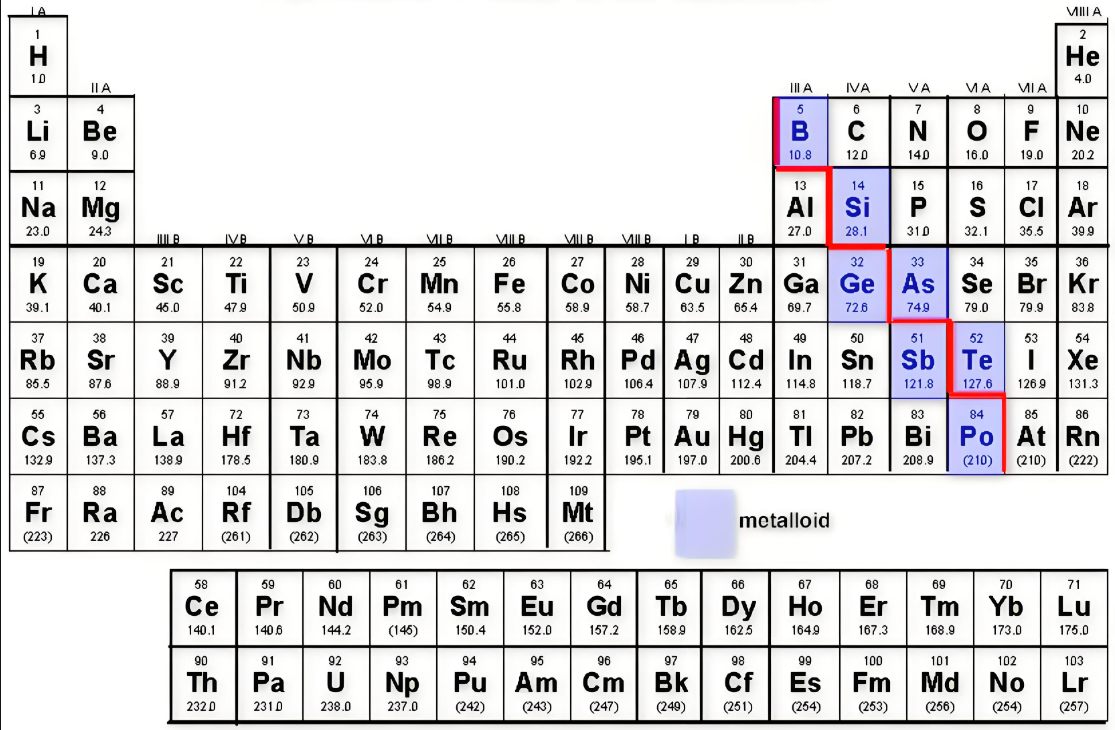Time to read: 6 min

Delve into the unique properties of metalloids, elements that possess characteristics of both metals and nonmetals. This article explores their physical traits, electrical conductivity, and chemical behavior, emphasizing their significance in modern electronics and materials science, all while optimizing for search engine visibility with strategic keyword placement.
1. Metalloids: Solid Elements with High Melting Points
All metalloids are solid at room temperature and boast high melting points, a property that distinguishes them within the periodic table. This attribute is crucial when discussing the properties of metalloids, as it influences their applications in various industries.
2. Metalloids' Metallic Luster and Appearance
Metalloids may not be metals, but they exhibit a metallic luster, which is why they are aptly named. Their reflective surfaces and metallic appearance are key properties of metalloids, as depicted in the visual representation of their physical characteristics.
3. Brittleness: A Defining Trait of Metalloids
Unlike metals that can be shaped through cold-forming techniques, metalloids are brittle and prone to breaking. This property of metalloids is important to consider when evaluating their mechanical applications.
4. Semiconductor Properties of Metalloids
Metalloids' ability to conduct electricity, though not as efficiently as metals, is a defining feature. Their semiconducting behavior is pivotal in electronic circuitry, with the process of doping enhancing their semiconductor properties for various applications, a key aspect of the properties of metalloids.
5. Chemical Behavior: A Blend of Metals and Nonmetals
Metalloids display chemical properties akin to nonmetals, forming anions, exhibiting multiple oxidation states, and preferring covalent bonds. Their oxidation states, as listed, underscore this dual chemical nature, which is a significant part of understanding the properties of metalloids.
6. Ionization Energies and Electronegativities: The Middle Ground
Metalloids' ionization energies and electronegativities fall between those of metals and nonmetals, influencing their bonding behavior and electron sharing in chemical reactions. This intermediate status is essential for grasping the properties of metalloids.
Distinguishing Metalloids: More Than Semiconductors
Metalloids are not just semiconductors; they embody the characteristics of both metals and nonmetals. Their versatility in electronics is unparalleled, making them indispensable in our technology-driven era, and a critical component when discussing the properties of metalloids.
Applications of Metalloids: A Glimpse into Their Utility
Commonly recognized metalloids, along with their descriptions and applications, are detailed below. Each element plays a distinct role, from silicon in semiconductors to antimony in paint pigments, all of which are integral to understanding the properties of metalloids.
Table 9. Metalloids: A Spectrum of Properties and Applications
| Element | Description | Application |
|---|---|---|
| Boron | A hard, heat-resistant allotropic semimetal with atomic number 5. | Used in the production of thermal shock-resistant glass. |
| Silicon | A gray, shiny, semiconductive metal with high melting and boiling points, atomic number 14. | Widely used in semiconductor manufacturing, a hallmark of the properties of metalloids. |
| Germanium | A hard, brittle element, atomic number 32. | Employed less frequently in semiconductors, still an important part of the properties of metalloids. |
| Arsenic | A steel-gray, poisonous semimetal, atomic number 33. | Utilized as an insecticide, showcasing the diverse applications of metalloids. |
| Tellurium | A brittle chalcogen, atomic number 52. | Added to steel to enhance machinability, another example of the properties of metalloids in action. |
| Antimony | A hard, brittle semimetal, atomic number 51. | Used in paint pigments and as an alloy with lead, demonstrating the versatility of metalloids. |
Table 10. Contrasting Metals and Nonmetals
| Properties | Metals | Nonmetals |
|---|---|---|
| Electrical Conductivity | Generally conductive | Nonconductive; act as insulators |
| Mechanical Properties | Vary from hard to soft, ductile to brittle. | Generally brittle and hard, not suitable for mechanical applications |
| Thermal Conductivity | More thermally conductive than nonmetals | Less thermally conductive |
| Form | Solids at room temperature, with a few exceptions | Can be gases, liquids, or solids |
Conclusion:
Understanding the properties of metalloids is crucial for advancements in material science and electronics. Their unique blend of metallic and nonmetallic traits positions them as key players in technological innovations. Unofactory, with its expertise in manufacturing and materials, can leverage these properties of metalloids to create cutting-edge solutions.




